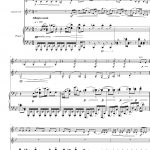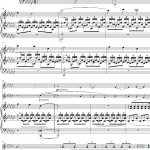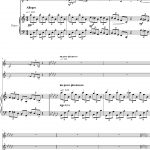2004c
violin, clarinet, piano
17'
Commissioned by the Bartók Trio (Marta Abraham, Nancy Braithwaite, Bas Verheijden), financially supported by the ThuisKopiefonds. 1st perf. November 2004, Kromme Rijn Concerts, Dutch Reformed Church, Bunnik.
-
- Mesticcio
- Nocturne
- Jeu-parti
a note on the music
The Trio for violin, clarinet and piano (2004) was specially commissioned by the Bartók Trio: Hungarian violinist Marta Abraham, American clarinettist Nancy Braithwaite and Dutch pianist Bas Verheijden. They presented it as a companion piece to Bartók’s Contrasts. Like Bartók, I am deeply attracted to Haydn, Mozart and Beethoven, composers who, like Bartók himself, knew how to mix folk music into their own style and who, each in his own very different way, used the classical ‘sonata form’ to this end. Like Bartók, I use folk music that is culturally significant for me. In this piece figure, for example, Dutch 17th-century song and twentieth-century ‘popular’ music, which are combined with early modern music, and even Bartókian ‘folk-like’ chromaticism.
The first movement of this Trio, a Mesticcio, is truly of ‘mixed blood’: a mixture of different musical styles, the roots of which seek to intermingle deep down in the endlessly variegated soil of classical sonata form – even though it is one that lacks the customary thematic return but instead is an example of what I feel is an ‘open’ sonata form that uses its initial strong contrasts to create new opportunities of melodic and rhythmic transformations (always clearly audible for the listener, I imagine).
The second movement is a capricious Nocturne in the manner of Bartók’s “night musics”. Where in Bartók his music refers to nature, folk dance, and hymnal songs, my night music is brimming with demonic, dreamlike music-historical emergences some of which refer to the West (Schoenberg, quoting from his op. 19), some to the East. Here, as in Bartók, the Indonesian gamelan has a significant role to play (in particular a Balinese dance melody to exorcise the devil), though for me, being of Indonesian-Dutch heritage, it has a very different emotional meaning than it may have had for Bartók.
The third movement is called “Jeu-parti”, harking as far back as the alternate chant between lover and beloved practiced by the medieval troubadours and trouvères. The instruments longingly sing to one another in different styles, eventually finding one another in a tango-like dance. The piano responds to this by paraphrasing a beautiful ancient melody that I found in Adrian Valerius’ ‘Gedenck-Clanck’ from 1626: ‘Come Sheap-herders deck your heds’. The song (with its originally tragic text) heralds the tragic conclusion of impossible love with which the tango, upon its return remembering us of several motives from earlier movements, brings the work to a desperate close.
The images below show the first pages of each movement.
The clips below have been taken from the recording of the first performance by the Dutch Concertzender.


